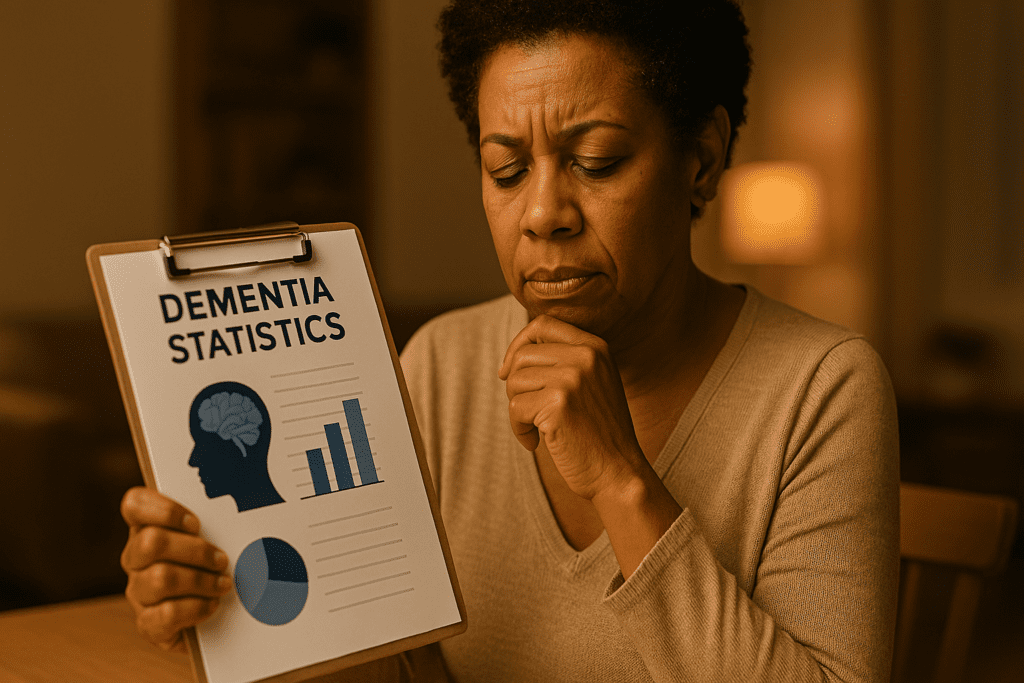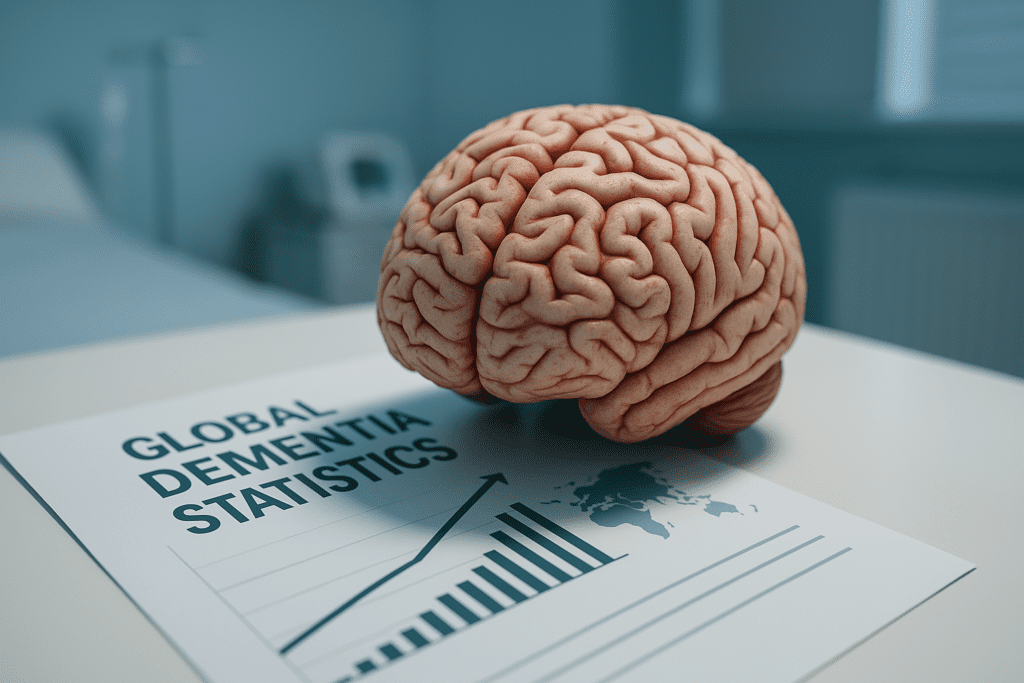Dementia, a complex neurocognitive syndrome that profoundly impacts memory, reasoning, and daily function, is emerging as one of the most pressing public health issues of the 21st century. While once viewed as an inevitable consequence of aging, dementia is now recognized as a dynamic condition with multiple risk factors, some modifiable, others not. But one of the most alarming trends in recent decades is the steadily increasing prevalence of dementia across the globe. As scientific research evolves, understanding why dementia is on the rise requires a multifaceted approach, integrating insights from epidemiology, neuroscience, population aging, and social determinants of health. This article explores the latest dementia statistics, examines the average age of dementia onset, and investigates the global forces fueling its rising trajectory.
You may also like: How to Prevent Dementia and Alzheimer’s Disease Naturally: Expert-Backed Strategies to Reduce Your Risk Through Lifestyle and Diet
Understanding the Scope: How Many People Get Dementia?
To fully grasp the scope of the dementia epidemic, it is crucial to ask: how many people have dementia today, and how many are expected to develop it in the coming years? According to the World Health Organization (WHO), more than 55 million people currently live with dementia worldwide, and that number is projected to reach 78 million by 2030 and 139 million by 2050. These figures reflect not only improvements in diagnosis and tracking but also the sheer scale of global aging. As lifespans increase, more individuals live into the age ranges most associated with neurodegenerative disorders.
When exploring dementia statistics in greater depth, one finds stark disparities across regions. For instance, high-income countries have more developed diagnostic infrastructure, leading to higher reported cases, while lower-income regions may underestimate dementia prevalence due to limited access to healthcare. Nonetheless, the trend is consistent across all demographics: dementia is growing more common year by year. In addressing how many people get dementia, researchers emphasize the need to distinguish between incidence (new cases each year) and prevalence (total number of existing cases). Both metrics are climbing steadily, driven by demographic transitions and shifting risk profiles.
Dementia Prevalence Percentage and Global Demographic Shifts
The dementia prevalence percentage varies across countries, but recent global meta-analyses suggest that approximately 5 to 8 percent of individuals aged 60 and older live with dementia. In some regions, this prevalence climbs even higher, particularly where risk factors like cardiovascular disease, diabetes, and low education levels are widespread. This broad range reflects not just differences in lifestyle and genetics, but also variances in healthcare access, early screening, and diagnostic accuracy.
One cannot discuss the rising rates of dementia without acknowledging the profound demographic changes underway globally. Population aging is perhaps the single most significant driver of dementia prevalence. As birth rates decline and life expectancy increases, societies are witnessing an unprecedented shift in age structure. The result is a larger proportion of individuals living into their 70s, 80s, and beyond—age brackets in which the risk of developing dementia increases exponentially.
For public health professionals and policymakers, this demographic shift poses a dual challenge: planning for increased demand on long-term care systems while also investing in preventive health measures. These include initiatives to reduce known dementia risk factors and promote cognitive resilience throughout the life span.
What Age Do People Get Dementia?
A commonly asked question is what age do people get dementia, and the answer is not as straightforward as one might assume. While dementia is most commonly associated with aging, the age at which it develops can vary widely depending on genetic, environmental, and lifestyle factors. For the majority of individuals, symptoms begin after the age of 65, but early-onset dementia—defined as dementia diagnosed before age 65—accounts for up to 9 percent of all cases.
This variation is particularly important in framing healthcare strategies. Early-onset dementia presents unique challenges, as affected individuals are often still employed, supporting families, or involved in caregiving themselves. Moreover, because it is less expected, early-onset dementia is frequently misdiagnosed or underdiagnosed, leading to delays in treatment and support. Understanding the dementia age range is therefore essential not just for clinicians but also for employers, caregivers, and social support systems.
Beyond the clinical setting, knowing the average age of dementia onset helps inform policy around retirement planning, disability benefits, and long-term care resources. The broader public also benefits from greater awareness about age-related risks and the value of early detection.
Average Age of Dementia and Alzheimer’s Onset
When examining the average age of dementia onset, it is important to distinguish between different types of dementia, the most common of which is Alzheimer’s disease. The Alzheimer average age of diagnosis typically falls around 75, though variations exist based on factors such as sex, education, family history, and comorbid conditions. Other types of dementia, such as frontotemporal dementia or Lewy body dementia, may present earlier or manifest differently.
Although age remains the most significant non-modifiable risk factor for dementia, new research underscores the role of midlife factors—like hypertension, obesity, and physical inactivity—in influencing when and how the disease emerges. Consequently, public health campaigns increasingly focus on lifestyle interventions that begin decades before symptoms typically appear.
Knowing the average age of dementia is crucial for shaping screening recommendations. For example, individuals with a strong family history of Alzheimer’s may begin cognitive evaluations in their early 60s, if not earlier. On a population level, understanding these age benchmarks allows healthcare systems to better allocate diagnostic resources and prepare for future service needs.

What Percentage of People Get Dementia?
Understanding what percentage of people get dementia is central to evaluating its impact on society. Epidemiological studies suggest that about one in nine people over age 65 has some form of dementia, with prevalence doubling approximately every five years after that. By age 85, nearly one-third of individuals may be affected. Among those with a family history or other risk factors, the likelihood can be even higher.
Looking at what percent of people form dementia by age 60 reveals a less dramatic, but still significant, picture. While the overall percentage in this age group remains under 2 percent, the fact that dementia can appear at such an early stage is a growing concern, especially as lifestyle-related risk factors such as diabetes and obesity become more common in younger populations. These trends call for earlier interventions and greater public awareness about the modifiable aspects of cognitive health.
In sum, the answer to what percentage of people get dementia is not fixed but depends on age, risk profile, and geographic region. That said, as populations continue to age, these percentages are likely to increase unless significant breakthroughs in prevention or treatment emerge.
Why Is Dementia on the Rise?
Answering the question of why is dementia on the rise involves dissecting a constellation of interconnected factors. As previously noted, population aging is the most significant driver. However, other contributors include increased detection and reporting, lifestyle trends, environmental exposures, and chronic disease burdens. Greater awareness and improved diagnostic criteria have enabled healthcare professionals to identify dementia cases that might have gone unrecognized in previous decades.
Rising rates of obesity, physical inactivity, and poor cardiovascular health across many countries are also playing a role. These conditions contribute to vascular dementia and exacerbate Alzheimer’s disease pathology. Simultaneously, air pollution, poor sleep quality, social isolation, and chronic stress are being investigated as potential contributors to cognitive decline.
In many respects, the rising prevalence of dementia reflects broader societal transformations. Urbanization, longer work hours, diminished community networks, and increased screen time have shifted how people interact with their environments and each other. These factors may influence brain health indirectly through changes in lifestyle, sleep, and social engagement—all important components of cognitive resilience.
How Old Do You Have to Be to Get Dementia?
There is no minimum age at which dementia becomes a possibility, though the probability increases markedly with age. When asking how old do you have to be to get dementia, it’s important to understand that dementia is not a normal part of aging, though the risk escalates over time. While it is rare for someone under 40 to develop dementia, such cases do exist, often driven by genetic mutations or traumatic brain injuries. However, for most people, the threshold of concern begins around age 60, especially when symptoms such as memory loss, confusion, or difficulty with familiar tasks emerge.
This age threshold holds significance for public health messaging. Many individuals mistakenly believe that dementia only affects the very old, leading to delayed diagnosis and lost opportunities for early intervention. By communicating that dementia can occur earlier—sometimes even in one’s 50s—health professionals can encourage proactive cognitive assessments and lifestyle modifications.
Moreover, understanding how old you have to be to get dementia helps reframe the disease not just as a geriatric issue, but as one with broad relevance across adult life stages. This broader framing can reduce stigma and foster a more inclusive conversation about brain health and cognitive aging.
Dementia Affects How Many People Worldwide?
As of 2024, dementia affects how many people globally is a question that highlights the staggering growth of the condition. With more than 55 million people currently affected and millions more added each year, the burden on individuals, families, and healthcare systems is immense. These numbers are not mere statistics—they represent lived realities marked by cognitive impairment, emotional distress, and increased dependence.
In many countries, the growing number of dementia cases is overwhelming existing healthcare infrastructure. From shortages in trained geriatricians to long wait times for diagnosis, the rising demand for services is straining systems not designed to handle chronic neurodegenerative conditions on such a scale. Family caregivers often bear the brunt of this gap, frequently providing unpaid support at great personal and financial cost.
Policy responses vary widely, but successful models often include community-based programs, caregiver training, and integrated healthcare systems that bridge primary care and specialist services. Understanding how many people get dementia is not just a numerical exercise—it is the first step in crafting compassionate, effective responses that address the human dimensions of this public health crisis.
Dementia Statistics and the Road Ahead
The future of dementia care and prevention hinges on robust, evidence-based dementia statistics. These data points guide everything from pharmaceutical research to public health campaigns. As such, improving data collection and standardization remains a high priority. Accurate dementia statistics allow stakeholders to anticipate care needs, allocate funding, and design interventions tailored to the unique needs of diverse populations.
For instance, regional data showing higher rates of dementia among women or in certain ethnic communities can inform targeted education and screening programs. Similarly, longitudinal studies tracking how many people have dementia over time can reveal trends related to environmental exposures, medical interventions, or societal changes. In an era of precision medicine, these nuanced insights are invaluable.
In addition to prevalence and incidence, researchers are increasingly focused on measuring quality of life, caregiver burden, and economic impact. These multidimensional statistics offer a fuller picture of dementia’s footprint and help to humanize what might otherwise be a sterile set of numbers.

Frequently Asked Questions: Understanding the Rising Prevalence of Dementia
1. How common is dementia among people in their 60s, and are early cases increasing?
Dementia among individuals in their 60s is becoming more frequently recognized due to increased awareness and improved diagnostic practices. While traditionally associated with advanced age, newer studies show that early-onset dementia is not as rare as once believed. Understanding what percent of people form dementia by age 60 reveals that nearly 1 to 2 percent of this age group may be affected. This small but significant percentage prompts consideration of lifestyle and genetic risk factors that may accelerate cognitive decline. As the dementia age range continues to broaden, early identification and intervention strategies are gaining momentum, particularly for individuals with a family history or chronic comorbidities like type 2 diabetes or cardiovascular disease.
2. What is the current dementia prevalence percentage globally, and how does it vary by region?
The global dementia prevalence percentage typically falls between 5 to 8 percent for individuals over age 60, though this varies widely by region due to socioeconomic, genetic, and environmental influences. In high-income countries with better healthcare access, diagnosis rates are higher, which may exaggerate apparent prevalence. However, in many low- and middle-income countries, dementia is underdiagnosed, leading to potentially underreported figures. This geographic disparity impacts how many people have dementia globally and underscores the importance of expanding screening and cognitive care infrastructure. A more nuanced understanding of dementia prevalence allows for the development of region-specific public health strategies that address culturally and medically relevant challenges.
3. What are some unexpected factors contributing to why dementia is on the rise?
While aging populations remain the primary driver of dementia prevalence, several less obvious factors are accelerating the trend. Air pollution, for instance, has recently emerged as a significant contributor to neuroinflammation, which may elevate dementia risk over time. Additionally, societal shifts such as increased screen time, social isolation, and sleep disruption are being explored as long-term cognitive health threats. As researchers investigate why dementia is on the rise, lifestyle changes and urban environmental exposures are gaining attention alongside traditional medical risk factors. Understanding how these new dimensions influence brain aging can help reshape public health messaging and preventive approaches.
4. How old do you have to be to get dementia, and is the risk truly age-dependent?
The notion that one must be elderly to develop dementia is increasingly being challenged. While the average age of dementia onset is still over 70, early-onset cases often emerge in people as young as their 40s and 50s, particularly in cases with hereditary or trauma-related causes. So when asking how old do you have to be to get dementia, it’s important to recognize that cognitive decline can begin much earlier than traditional retirement age. Although age remains a powerful risk factor, it’s not the only determinant. Environmental, genetic, and lifestyle influences shape risk well before the age at which symptoms manifest, urging a shift in how we view and approach early brain health.
5. What social implications arise from the growing number of people with dementia?
The rising number of dementia cases is reshaping societal norms around caregiving, employment, and intergenerational dynamics. As more individuals develop dementia earlier in life, families face challenges balancing caregiving responsibilities with careers and financial obligations. The question of how many people get dementia is no longer confined to the elderly—it now affects younger caregivers, workforces, and educational institutions as well. Additionally, stigma surrounding dementia remains a barrier to early diagnosis and inclusion. As the dementia prevalence percentage continues to grow, societies must invest not just in medical infrastructure, but also in legal protections, financial planning resources, and supportive community networks.
6. How does the average age of dementia diagnosis differ between Alzheimer’s and other forms?
The average age of dementia onset varies depending on the subtype. For Alzheimer’s disease—the most common form—the Alzheimer average age of diagnosis typically falls in the mid-70s. However, vascular dementia or frontotemporal dementia may present significantly earlier, sometimes in one’s late 50s or early 60s. This variation complicates efforts to generalize the average age of dementia across populations, requiring subtype-specific awareness campaigns and clinical screening criteria. Understanding these nuanced distinctions improves patient outcomes by ensuring timely, tailored interventions that address the diverse forms of cognitive impairment.
7. Are there gender differences in dementia prevalence or onset age?
Emerging research suggests that women are disproportionately affected by dementia, both in prevalence and in severity of symptoms. While part of this may reflect the fact that women tend to live longer—a factor closely tied to the average age of dementia—there may also be hormonal, genetic, and biological differences at play. For instance, the dementia age range for women may skew slightly higher, but their symptoms may progress more rapidly post-diagnosis. Differences in healthcare access and gender-related biases in diagnostic practices further complicate dementia statistics. Addressing these disparities will require a gender-informed approach to brain health across the lifespan.
8. What percentage of people get dementia in aging populations, and what does this mean for health systems?
As lifespans increase, the question of what percentage of people get dementia becomes more urgent for public health planning. Among individuals over 85, nearly 30 to 35 percent may develop some form of dementia. This surge in older adult diagnoses is exerting pressure on health systems, particularly in areas lacking geriatric specialists or dementia-specific long-term care. The growing awareness of how many people have dementia forces healthcare infrastructures to rethink staffing, training, and resource allocation. Preparing for a future where a significant portion of the elderly population requires cognitive support is essential for sustainability and quality of care.
9. Can population-based screening help detect dementia earlier, especially in at-risk groups?
Population-based screening has the potential to catch early cognitive decline in high-risk groups, potentially shifting the average age of dementia diagnosis to earlier, more manageable stages. These screenings are particularly effective when focused on individuals with chronic conditions like hypertension, obesity, or a strong family history. Public health experts are also considering how to apply dementia statistics to improve predictive tools that identify at-risk individuals long before symptoms interfere with daily life. Early detection not only delays disease progression but may also offer access to emerging therapies that work best during the earliest phases of neurodegeneration. In doing so, we may be able to influence how common is dementia among future generations.
10. How can emerging technology reshape the landscape of dementia diagnosis and care?
New technologies—ranging from AI-powered brain scans to wearable cognitive trackers—are revolutionizing how dementia is diagnosed and monitored. These innovations could dramatically shift how many people get dementia detected in the earliest stages, long before symptoms become debilitating. By identifying biomarkers that correlate with early structural brain changes, clinicians may soon be able to refine the average age of dementia onset estimates and tailor interventions accordingly. Additionally, smart home systems are being tested to support independent living among those with early-stage dementia, reducing caregiver burden. As the dementia age range continues to evolve, these tech-driven approaches offer a glimpse into a more proactive, personalized future in cognitive health care.

Conclusion: Navigating the Rising Tide of Dementia with Insight and Action
As dementia prevalence continues to rise globally, the urgency to understand its scope, origins, and trajectory has never been greater. By unpacking key issues such as the average age of dementia onset, the dementia prevalence percentage, and how many people get dementia each year, we equip ourselves to respond with foresight and compassion. Knowing what age people get dementia and what percentage of people form dementia by age 60 is more than a matter of academic interest—it’s foundational for building healthcare systems, educational campaigns, and social services that are prepared for the future.
The question of why is dementia on the rise cannot be answered in isolation. It demands an integrated perspective that spans biology, public policy, environment, and culture. From the shifting dementia age range to the expanding global footprint reflected in recent dementia statistics, the message is clear: we must act now. Greater investment in brain health education, research on modifiable risk factors, and support for caregivers will be essential pillars in managing this growing challenge.
Ultimately, the rise in dementia prevalence presents both a warning and an opportunity. With the right strategies grounded in science and compassion, society can move toward a future where the burden of dementia is reduced, and individuals facing cognitive decline are met with understanding, resources, and hope.
neurodegenerative disorders, brain aging, cognitive decline risk factors, aging population health, Alzheimer’s risk, neurological disease trends, early-onset cognitive disorders, brain health education, global mental health trends, cognitive impairment care, memory loss in aging, aging brain changes, cognitive health strategies, elderly healthcare planning, long-term care for dementia, mental health in older adults, geriatric neurology, preventive brain health, cognitive disorder diagnostics, dementia caregiver support
Further Reading:
Dementia Incidence Continues to Increase with Age in the Oldest Old The 90+ Study
New cases of dementia are rising in elderly populations in Wales, UK
2023 Alzheimer’s disease facts and figures
Disclaimer
The information contained in this article is provided for general informational purposes only and is not intended to serve as medical, legal, or professional advice. While Health11News strives to present accurate, up-to-date, and reliable content, no warranty or guarantee, expressed or implied, is made regarding the completeness, accuracy, or adequacy of the information provided. Readers are strongly advised to seek the guidance of a qualified healthcare provider or other relevant professionals before acting on any information contained in this article. Health11News, its authors, editors, and contributors expressly disclaim any liability for any damages, losses, or consequences arising directly or indirectly from the use, interpretation, or reliance on any information presented herein. The views and opinions expressed in this article are those of the author(s) and do not necessarily reflect the official policies or positions of Health11News.


